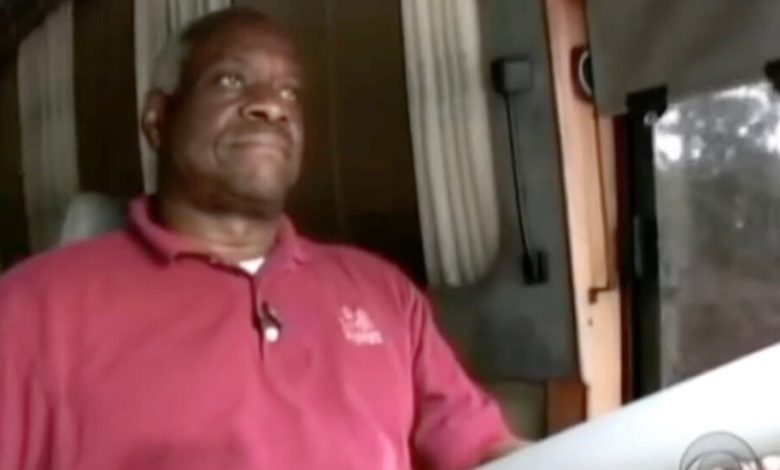Justice Thomas’s R.V. Loan Was Forgiven, Senate Inquiry Finds

The terms of the private loan were as generous as they were clear: With no money down, Justice Clarence Thomas could borrow more than a quarter of a million dollars from a wealthy friend to buy a 40-foot luxury motor coach, making annual interest-only payments for five years. Only then would the principal come due.
But despite the favorable nature of the 1999 loan and a lengthy extension to make good on his obligations, Justice Thomas failed to repay a “significant portion” — or perhaps any — of the $267,230 principal, according to a new report by Democratic members of the Senate Finance Committee. Nearly nine years later, after Justice Thomas had made an unclear number of the interest payments, the outstanding debt was forgiven, an outcome with ethical and potential tax consequences for the justice.
“This was, in short, a sweetheart deal” that made no logical sense from a business perspective, Michael Hamersley, a tax lawyer who has served as a congressional expert witness, told The New York Times.
The Senate inquiry was prompted by a Times investigation published in August that revealed that Justice Thomas bought his Prevost Marathon Le Mirage XL, a brand favored by touring rock bands and the super-wealthy, with financing from Anthony Welters, a longtime friend who made his fortune in the health care industry.
In a statement to The Times this summer, Mr. Welters said the loan had been “satisfied” in 2008. He declined to answer whether that meant Justice Thomas had paid off the loan in full; nor did he respond to other basic questions about the terms. But while a number of questions remain, he gave a much fuller account to the committee, which has the authority to issue subpoenas and compel testimony.
The documents he volunteered indicate that, at the very least, Justice Thomas appears to have flouted an ethics rule requiring that he include any “discharge of indebtedness” as income on required annual financial disclosure reports. In addition, the Internal Revenue Service treats debt forgiveness as income to the borrower.
Senator Ron Wyden, the Oregon Democrat who leads the Senate Finance Committee, called on Justice Thomas to “inform the committee exactly how much loan was forgiven and whether he properly reported the loan forgiveness on his tax return and paid all taxes owed.”
Justice Thomas did not respond immediately to questions sent to him through the Supreme Court’s spokeswoman.
In recent months, amid a series of reports of ethical lapses, the Supreme Court has faced intense public pressure to adopt stricter ethics rules, with several justices publicly endorsing such a move. Much of the controversy has centered on how wealthy benefactors have bestowed an array of undisclosed gifts on Justice Thomas and his wife, Virginia Thomas: buying and renovating the home where his mother lives, helping to pay for his great-nephew’s tuition and hosting the couple on lavish vacations that included travel aboard private jets and superyachts.
But in terms of its combined monetary and image-crafting value, few of those benefits can rival the motor coach. For years, it has served as a central trope of the justice’s “just-folks” persona: In speeches, interviews with “60 Minutes” and other television programs, and a hagiographic documentary financed by conservative supporters, Justice Thomas has extolled the joys of driving the motor coach through the American heartland in summertime and chitchatting with the people he meets in Walmart parking lots along the way.
Always left out of that telling, however, was just how much the motor coach cost — and how the financially hard-pressed justice managed to acquire it. According to title and other records unearthed by The Times, he bought it used in December 1999 for $267,230. (In today’s dollars, adjusted for inflation, that would be $493,700.) The title listed Mr. Welters as the lien holder.
The two men were close, bonded by similarly impoverished childhoods and the shared professional experience of working first as aides to Republican senators on Capitol Hill and later as political appointees in the Reagan administration. As Mr. Welters put it in his statement to The Times: “I loaned a friend money, as I have other friends and family. We’ve all been on one side or the other of that equation.”
Still, it would have been exceedingly difficult for Justice Thomas to obtain a bank loan for the coach — let alone one with the terms Mr. Welters offered. According to industry experts, even financial institutions that specialize in recreational vehicles are reluctant to lend on used luxury motor coaches like the Prevost Marathon, in part because their high level of customization makes them difficult to value. Moreover, financial disclosures and other records show that the Thomases relied primarily on his judicial salary for income, and were already carrying a heavy debt load. By contrast, the experts said, most buyers are high-wealth individuals who can pay cash, or put a substantial amount down and have excellent credit.
Mr. Welters, in response to questions from the Finance Committee, shared loan documents dated Dec. 6, 1999, showing that he lent Justice and Mrs. Thomas the entire purchase amount at an annual interest rate of 7.5 percent. While that rate was in line with what might have been found in the marketplace at the time, what made the arrangement unusually favorable was that over the course of the five-year loan, Justice Thomas did not have pay down any of the principal.
Instead, he simply had to make annual interest payments of $20,042. The principal amount borrowed would come due in a balloon payment on the loan’s maturity date, in December 2004. Vehicle loans like this one are very uncommon, experts said, because of the risk to the lender: The value of the collateral securing the loan — in this case, a motor coach — depreciates rapidly, while the outstanding principal remains constant.
In a handwritten note to Mr. Welters on his Supreme Court letterhead, dated the same day the loan documents were signed, Justice Thomas said the loan agreement should accurately reflect their understanding, and promised to abide by it to the letter, according to the Senate report.
But in 2004, when the principal came due, Justice Thomas did not make good on his debt, according to records obtained by the committee and cited in their report. Instead, Mr. Welters granted him a 10-year extension, with the same interest-only terms. This, despite the fact that the previous year Justice Thomas had collected $500,000 of a $1.5 million advance for his autobiography, according to his financial disclosures.
Then, in late 2008, Mr. Welters simply forgave the balance of the loan, according to the committee’s report.
In a contemporaneous note to Justice Thomas, summarized by the investigators, Mr. Welters said he was doing so because the justice’s many years of “interest only” payments now exceeded the purchase price of the bus. For that reason, Mr. Welters told Justice Thomas, he did not feel it was appropriate to continue to accept payments, even though he had the right to them.
But Mr. Welters’s math doesn’t add up: Even if Justice Thomas had made all the scheduled annual interest-only payments, that would only amount to a little over $180,000 — nearly $87,000 short of the purchase price. What’s more, the only proof of payment that Mr. Welters was able to provide to investigators was a copy of a single canceled check, dated December 2000, for $20,042 — the amount of a single interest payment.
Mr. Welters’s representatives told investigators that he believes there may have been additional interest payments — and, with less certainty, perhaps payment of some fraction of the principal, according to an aide to Mr. Wyden. But “none of the documents reviewed by committee staff indicated that Thomas ever made payments to Welters in excess of the annual interest on the loan,” the report said.
“No bank behaving in a commercially reasonable, arms-length manner would have given that loan in the first place,” said Mr. Hamersley, the tax expert. “And a bank doesn’t just say, ‘Oh gee, you’ve paid a lot in interest — we’re good, no need to pay back what you actually owe.’”
Mr. Welters, in a statement to The Times on Wednesday, said that because the loan was made so many years ago, “bank records — which I have sought — no longer exist. While not a tangible record, I continue to put stock in my contemporaneous belief.”
He added, “While I understand the attention given who this involves, the difference between what you’re comparing to and what happened here is that a friend lent another friend money. As anyone who has borrowed from or lent to family or friends knows, it’s simply not the same as a bank.”
That is a distinction the I.R.S. does not make. Assuming that the loan was entered into genuinely, and not intended from the start as an outright gift, the I.R.S. would treat the forgiven $267,230 — as well as any missed interest payments — as income to Justice Thomas, according to Mr. Hamersley and other experts.
Julie Tate contributed reporting.





